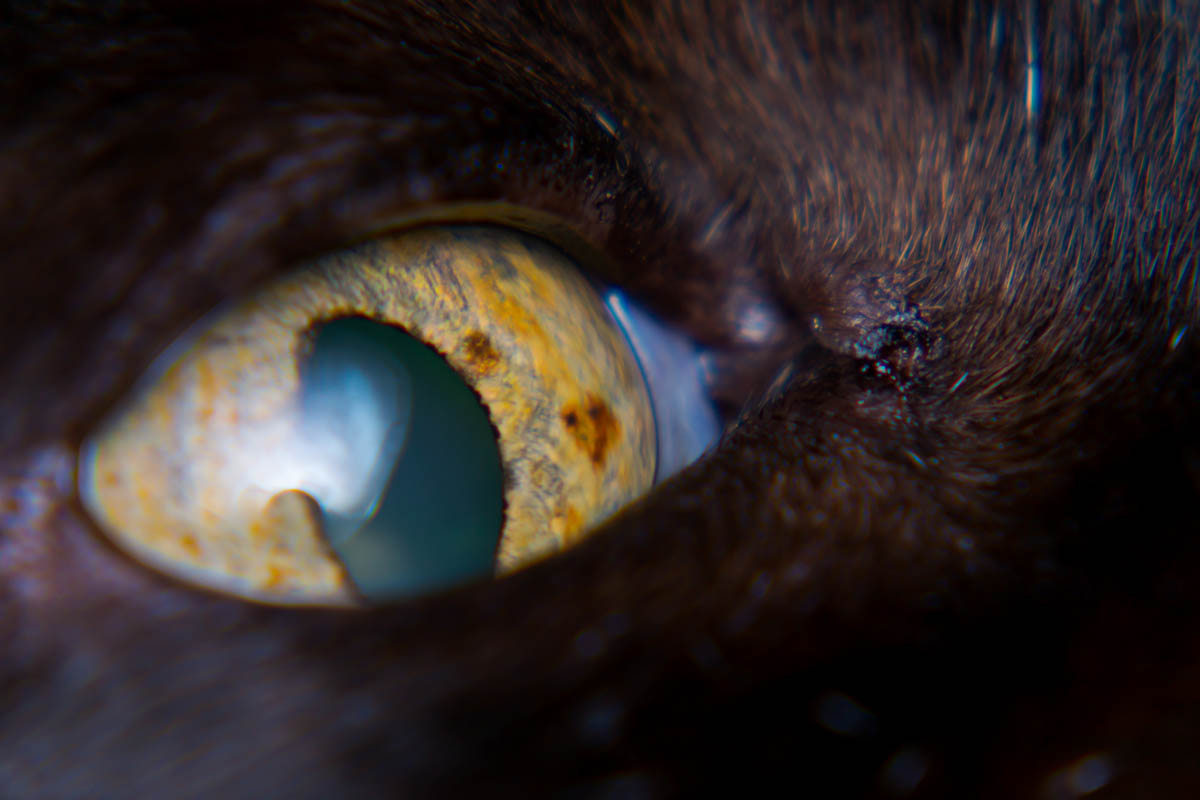Eye colour changes in cats can affect the iris, the pigmented muscular ring eye that circles the pupil or the pupils (the black part of the eye). There are several causes of eye colour changes in cats, the most common occurs when during kittenhood when the eyes change from blue to brown, yellow or green. Changes to the colour of the eye beyond kittenhood have multiple causes, from benign to life-threatening.
Kitten eye colour changes

All kittens are born with blue eyes because melanocytes produce melanin in response to light. Kittens are in complete darkness in the womb, and the eyes remain shut for the first 7 – 10 days after birth. Once the eyes open, melanin production begins, and eyes gradually change from blue to their genetically determined colour. Some kittens’ eyes will remain blue due to low numbers of melanin granules. Blue eyes are recessive to brown, yellow and green, which means both parents must pass on the blue-eyed gene for the kitten to have blue eyes.
Uveitis
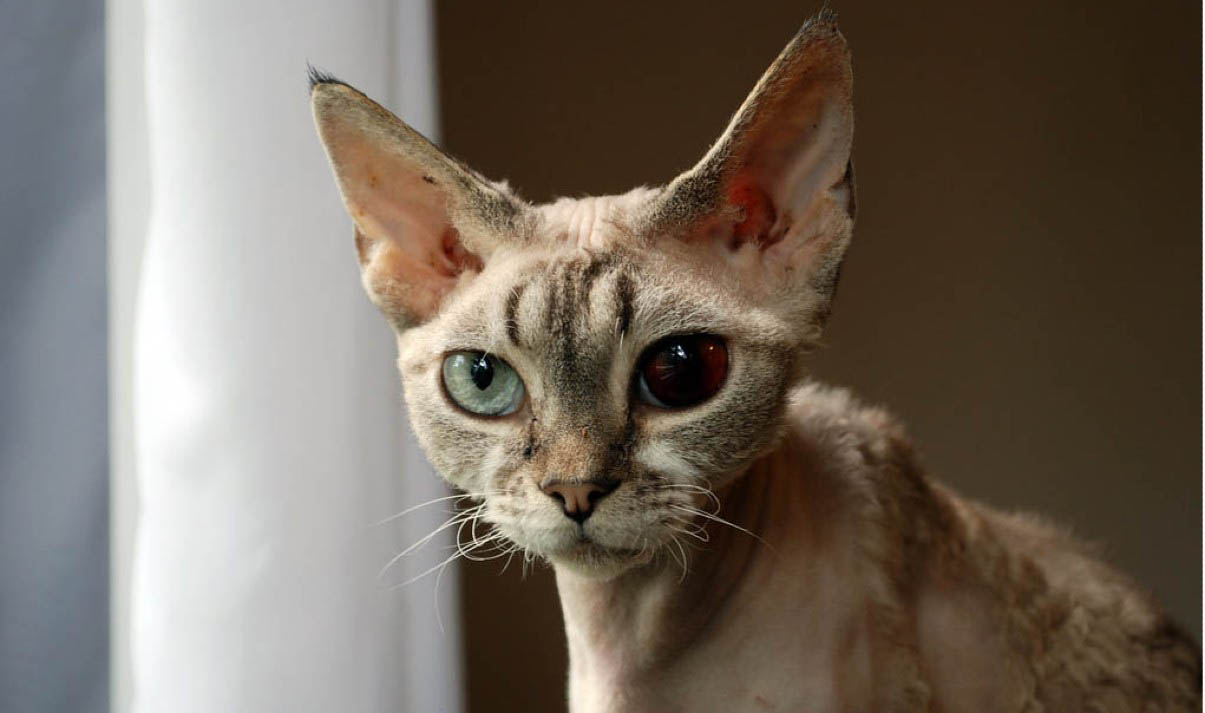
Uveitis is an inflammation of the uvea, which is pigmented layer of the eye that lies between the inner retina and the outer fibrous layer composed of the sclera. Affected cats develop redness or a cloudy appearance to the eye. There are a number of causes of uveitis in cats including immune-mediated, diabetes, cancer, trauma, infectious and high blood pressure. One of both eyes can develop uveitis, which can help the veterinarian narrow down the possible cause.
Clinical signs: Squinting, redness, pain, abnormal pupil shape and a or cloudy appearance to the front of the eye
Iris melanosis
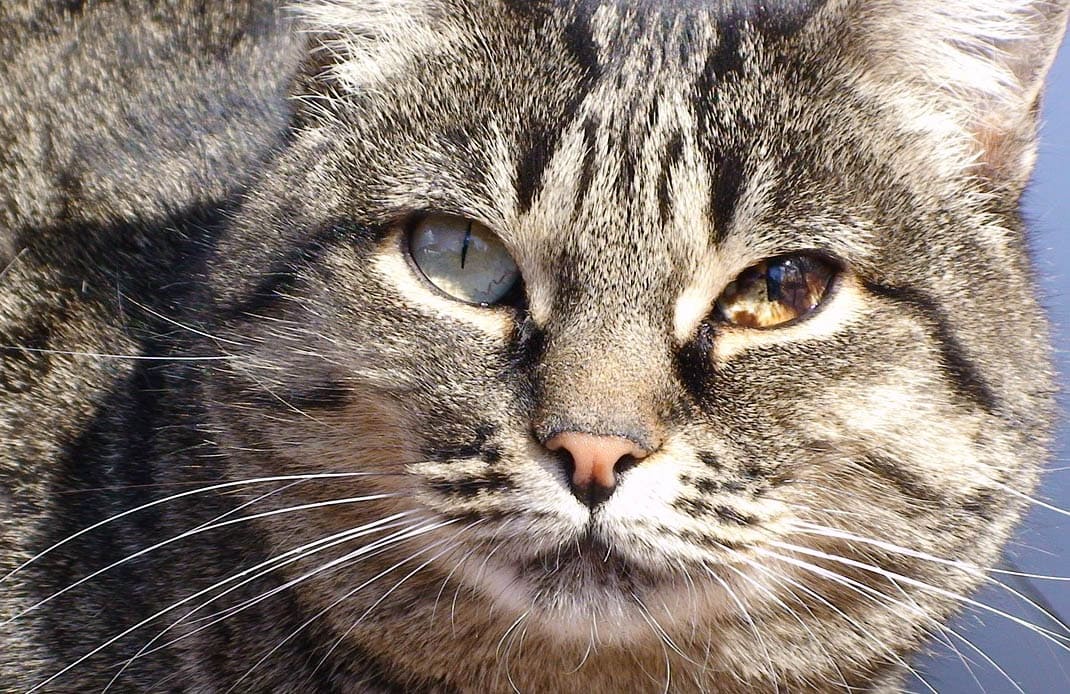
Iris melanosis is the appearance of brown spots in the iris, caused by the increased proliferation of melanocytes (cells responsible for the production of pigmentation) which spread across the surface of the iris. This condition is benign, but can potentially transform to malignant melanosis, which is life-threatening.
Clinical signs: Brown spots start out small, and gradually increase in size. While the condition is benign, it can lead to glaucoma in some cases and requires continual evaluation by a veterinarian.
Cataracts

Cataracts are an opacity of the lens, a crystalline structure that sits behind the pupil and iris, focusing light onto the retina. The lens is made up of an outer capsule, epithelium and fibres that are laid out in layers like an onion. Over time proteins build up in the lens, leading to a clouding of the lens. This affects vision, and pet owners may notice their cats bumping into objects.
Clinical signs: Grey hue to the eye(s), reduced vision. It is not uncommon for cataracts to be an incidental finding during a routine health check.
Nuclear sclerosis
Nuclear sclerosis is a common age-related change to the central portion of the lens in the eye. The lens epithelium continually produces new fibres, however, the lens is unable to accommodate these additional fibres, and packs the older fibres together towards the centre (nucleus) of the lens. Unlike cataracts, nuclear sclerosis doesn’t affect the cat’s vision as the lens fibres remain in their normal arrangements.
Clinical signs: Bilateral grey, circular cloudiness in the centre of the cat’s lens.
Anisocoria
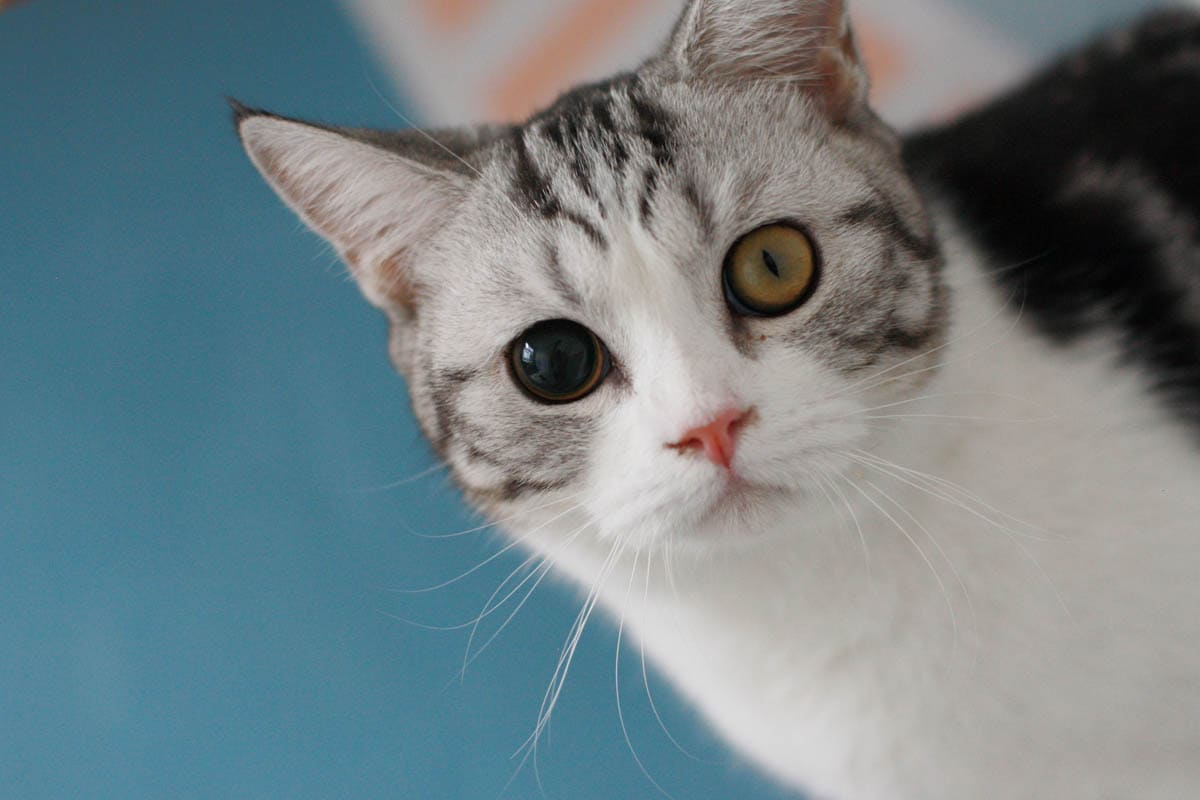
Normally, the pupils (the black portion of the eye) which dilate and contract according to light are the same size. Anisocoria is the medical term for uneven pupil sizes. The permanently dilated (enlarged) pupil gave the appearance of one dark eye and one light eye.
Causes of anisocoria include glaucoma, uveitis, corneal ulcer, spastic pupil syndrome, certain medications, tumours, oculomotor nerve paralysis, retinal detachment, Horner’s syndrome, stroke, head trauma, and iris atrophy.
Clinical signs: Unequal pupil size is the most apparent sign, other symptoms may vary depending on the cause, and include a drooping eyelid, head tilting, loss of vision, abnormal eye movement, confusion, and pain.
Glaucoma

Glaucoma is a group of eye diseases caused by a build up of intraocular pressure in the eye. The ciliary epithelium produces intraocular fluid. This fluid drains away at the drainage angle where the iris and cornea meet, and exits via a series of drainage canals (trabecular meshwork) where it is reabsorbed into the bloodstream. This fluid in/fluid out should occur at the same rate, to keep pressure within the eye stable. If the outward flow of fluid is reduced or blocked, a build-up occurs leading to an increase in intraocular pressure. This fluid build-up pushes against the internal structures of the eye and puts pressure on the optic nerve which transmits visual information from the retina to the brain. Damage to the optic nerve causes a progressive and eventual vision loss in the affected eye(s).
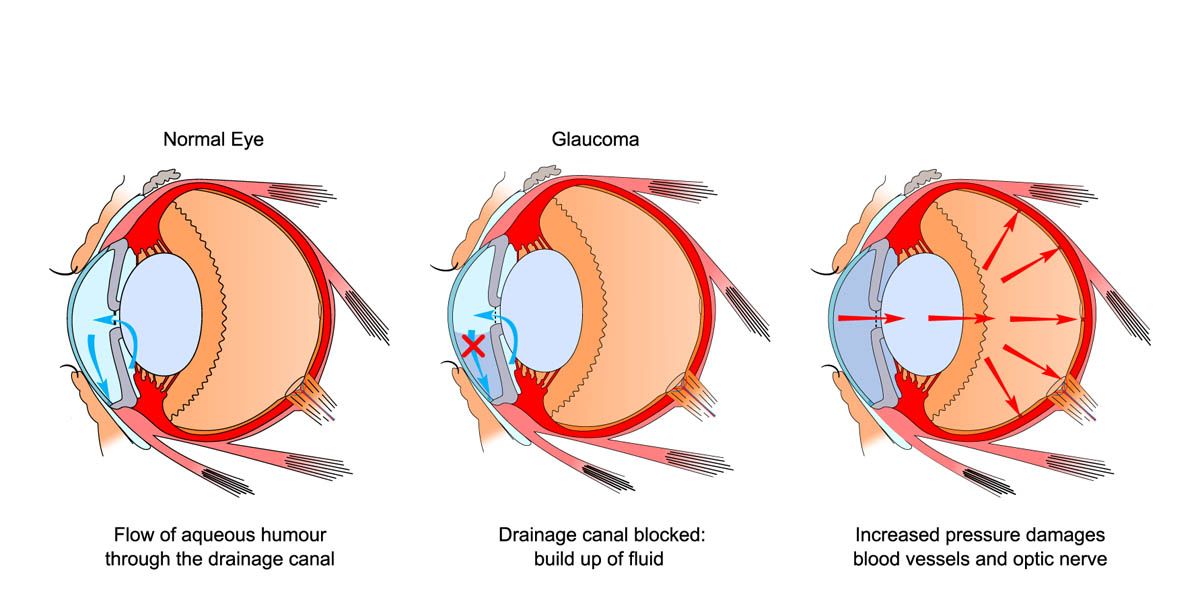
Clinical signs include pain, watery discharge, and in some cases a swollen eye. The word glaucoma comes from the ancient Greek word ‘glaukos‘, which means shimmering. This refers to the shiny hue the eye can develop.
Jaundice
Jaundice is a yellow discolouration of the skin, mucus membranes and eyes due to increased levels of bilirubin in the blood. This yellowish pigment occurs when heme, the iron portion of red blood cells is broken down. The macrophages break down old red blood cells into globulin and heme. Heme is metabolised into bilirubin which is bound to albumin and sent to the liver where it is conjugated (made water-soluble). From there moves to the gallbladder and then it empties into the intestine. Bacteria convert it into urobilinogen and it passes out of the body via the stool. Any dysfunction in the process leads to a build-up of bilirubin in the blood.
Jaundice falls into three categories, pre hepatic, hepatic and post hepatic.
Pre hepatic jaundice:
- Heinz-body anemia due to toxicity
- Blood type incompatibility
- Hemobartonellosis (parasitic blood infection)
Hepatic jaundice:
- Toxicity
- Inflammation
- Infection
- Cancer
Post hepatic jaundice:
- Gallstones
- Pancreatitis
- Bile duct blockage
- Cancer
Clinical signs: Unlike the other ocular changes which relate to pupil or iris colour changes, jaundice affects the white portion of the eye known as the sclera. Affected cats develop a yellow hue to the sclera as well as the skin and mucus membranes.
When to see a veterinarian?
A veterinarian should evaluate any changes to the cat’s eye(s). Untreated eye disorders can lead to complete blindness, and in some cases death in cats with untreated melanoma.
The veterinarian will perform a complete physical and ocular examination to narrow down the possible cause.
Diagnostic workup:
- Gonioscopy: A gonioscope and slit lamp evaluate the internal drainage angle of the eye where the cornea and iris meet.
- Slit lamp examination: A slit lamp is an instrument that consists of a microscope and high-intensity light. This enables the veterinarian to evaluate the structures at the front of the eye.
- Tonometry: A measure of the pressure inside the eye (intraocular pressure) to evaluate for glaucoma.
- Fluorescein stain: A dark orange dye (fluorescein) is placed onto the outer surface of the eye to look for corneal lesions.
- Ophthalmoscopy: The veterinarian uses a small handheld device (ophthalmoscope) to examine the inside of the cat’s eye.
- Complete blood count: A blood test that measures the cellular components of the blood (red blood cells, white blood cells and platelets.
- Biochemical profile: A test on the clear/fluid portion of the blood, the biochemical profile measures a number of chemicals and enzymes which provides important information on the status of organs and electrolytes.
Treatment
Some eye colour changes require no treatment at all, just a wait-and-see approach but other causes require prompt treatment to preserve the cat’s vision and ease discomfort. The type of care the cat will receive will depend on the underlying cause.
